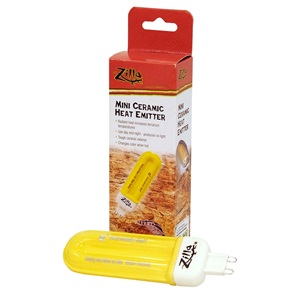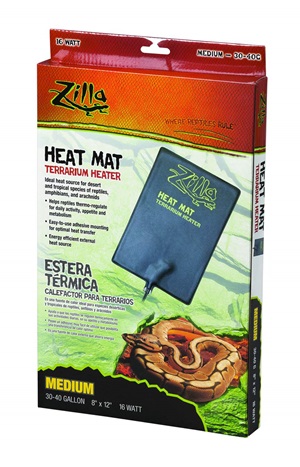Tips For Keeping Reptiles Healthy In Cold Weather
 When the weather gets colder, it’s important to ensure the changing climate outside doesn't affect your climate inside. Reptiles depend heavily on their environment, and for many, a drop in temperature or humidity levels can lead to sickness, shedding problems and even a decrease in energy.
When the weather gets colder, it’s important to ensure the changing climate outside doesn't affect your climate inside. Reptiles depend heavily on their environment, and for many, a drop in temperature or humidity levels can lead to sickness, shedding problems and even a decrease in energy.
Follow these cold-weather tips reptile care tips to make sure your pet is comfortable and healthy all year round.
Is Your House Getting Cooler? Add More Heat Sources To Your Terrarium.
As many reptile and amphibian caregivers know, heating and lighting is one of the most important elements in promoting long-term health. It’s essential for bone development, a healthy metabolism, keeping activity levels where they need to be, and it even helps regulate behavior.
If your house gets colder as the seasons change, your standard bulbs might not be providing adequate heat to your terrarium. In fact, you may want to consider upgrading your light source to something with a higher wattage to keep your terrarium temperature at the appropriate level. Even if your house temperature stays the same, it’s still a good idea to check if your UVB bulbs need to be changed. Even if they are still giving off light, the UVB will run out over time.
If necessary, consider adding extra heat sources to your enclosure. Just be careful not to overheat your animal, and don’t expose your pet to a heat source that may burn them.
Power Outages Can Mean Trouble For Your Cold-Blooded Pets.
Power outages are common in winter, and it’s best to be prepared.
The most important thing you can do is keep your reptiles warm. Most people have glass terrariums, and while they are beautiful and functional when you have power, glass will not maintain warmth inside the terrarium without an ongoing heat source. If the power goes out you must insulate your terrarium. Good insulating materials that you may have around your home, include: styrofoam, cork panels, polyethylene and bubble wrap. If you don’t have a access to any of these items, wrapping your terrarium in blankets and towels will work in a pinch. If possible, temporarily relocate your pet to a smaller enclosure that’s more easily heated.
If the temperature has already dropped considerably since the power was lost, be sure to warm your reptile up gradually before placing them directly in an enclosure or space that’s the temperature they need.
If power outages are common where you live, consider looking into battery powered lamps and reptile heating pads.
Air is Drier in Colder Months, Take Necessary Care.
 Many reptiles and amphibians need a certain level of humidity to stay healthy. You may not notice the air steadily becoming drier in winter months, but your pet certainly will. If the air becomes too dry, your reptile or amphibian may become dehydrated and sick.
Many reptiles and amphibians need a certain level of humidity to stay healthy. You may not notice the air steadily becoming drier in winter months, but your pet certainly will. If the air becomes too dry, your reptile or amphibian may become dehydrated and sick.
Dry air can also lead to dysecdysis, also called stuck shed, which is when a reptile goes through abnormal shedding. Dysecdysis can be caused by low levels of humidity, cool temperatures, improper diet or other environmental factors. Be especially cautious with younger reptiles, as they shed more often as they grow.
To prevent this problem use a humidity and temperature gauge to be sure your terrarium is maintaining proper heat and humidity levels. If you notice drier air, consider misting your terrarium more often and if needed, soak your reptile in a shallow bowl of warm water or wrap them in damp towel a few times a week.
Adding terrarium moss to your reptile enclosure is a great way to help keep humidity levels high because moss naturally holds a lot of moisture. Terrarium moss is a preferred bedding for chameleons, frogs, green anoles, rainforest geckos, toads, salamanders and newts. In drier months, it might be a good idea to add a little moss to the terrarium of your snake, skink or water dragon, especially if you are having trouble keeping the humidity levels up. If you’re not sure which bedding is best for your pet, view our Bedding Guide here.
Make sure your pet also has a humid hide, such as a rock lair, so they have an extra dark and humid hiding place to allow their skin to shed off naturally. The inside of the rock lair is designed to keep the humidity in, and the outside has a rough surface so that your pet can rub against it and remove sloughing skin.
If you notice that your pet is having a problem shed, pay special attention to the thinner parts of your pet such as tails, toes and spikes. This is important because the retained skin from a bad shed can constrict tissue, starving off oxygen and leading to the destruction of blood vessels, which may lead to the autoamputation of that extremity.
If you have taken the necessary steps and your pet is still having shedding problems, or alarmingly few sheds, see your veterinarian.
Zilla is committed to helping you build the best life for your reptiles. From creating the perfect habitat to providing resources for animal happiness and well-being, we want to be sure you have all the tools you need. Join the conversation and stay in the loop by liking us on Facebook or signing up for our monthly newsletter, the Zilla Zooletter.
